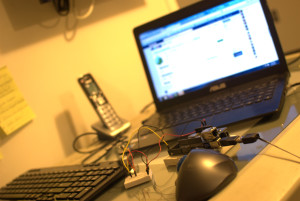Whether or not you’ve heard of aquaponics before, it’s likely you’ll be hearing a lot more about it before long. A combination of hydroponics (growing plants in water, without soil) and aquaculture (the farming of water creatures like fish and shellfish in tanks or pools), aquaponics creates a self-contained mini-ecosystem that produces quality output with extraordinary efficiency. With an increasing demand for efficiency and economy in food products, aquaponics systems are likely to become more common – and more sophisticated.
What is Aquaponics?
(If you’re already involved in or knowledgeable about aquaponics, you can skip this part and move on to the next sections. If not, let’s learn a little more about what aquaponics is.)
Basically, aquaponics systems create a symbiotic environment where plants and fish are raised in a single self-contained artificial ecosystem.
A standard system works like this:
- Fish kept in aquaculture tanks are fed normal fish feed or other food.
- Fish produce food waste which is rich in ammonia.
- Specially cultured bacteria in the system converts the ammonia in the fish’s waste into nitrates, which is tolerable to the fish.
- Plants use the converted nitrates as fertilizer, filtering the water in the process.
- Water is cycled throughout the system with a pump to keep fish in fresh, clean water and plants with nutrient-dense water. Oxygen is pumped into the water, as with a standard aquarium. Depending on the complexity and size of the individual system, one or more sump tanks and solid filtration devices may be employed.
To ensure optimum health of both plants and fish, the following additional measures should also be taken:
- Feeding fish at a rate specific to the needs of the overall system.
- Controlling water temperature and pH.
- Calcium, iron, and potassium supplementation.
Why automate aquaponics systems?
Basic aquaponics systems are currently popular among hobbyists and small-scale farmers, and while these systems are simple enough to keep functioning well with manual checks and effort, the kinds of systems that would be required for larger-scale systems will be too large and elaborate for efficient manual maintenance.
If you’re an aquaponics farmer looking to expand your operation, you may want to consider at least partially automating your system. Homeostasis and stability are a hugely important part of hydroponics, and as your system gets larger it’s going to be more difficult to accurately keep an eye on water flow rates, water temperature, water quality, tank levels, and even leaks.
How do you automate aquaponics systems?
The first step is with an accurate series of sensors to test for things like water levels, temperature, pH balance, and water flow speed. These sensors are then run through a computer system with specialized software like this one, in order to alert you as to when something is out of balance, or even automatically fix problems.
 For example, a liquid level sensor might detect that water levels in the system are low, signaling an alarm that will let you know to check for leaks and even automatically adding more water to compensate for the loss. Or, a temperature sensor might detect that the aquacultures tanks’ water is too cold, triggering a heating system to bring it back into the optimal range.
For example, a liquid level sensor might detect that water levels in the system are low, signaling an alarm that will let you know to check for leaks and even automatically adding more water to compensate for the loss. Or, a temperature sensor might detect that the aquacultures tanks’ water is too cold, triggering a heating system to bring it back into the optimal range.
FM22 – Combo Level/Temperature Switches
FT20 – Custom Temperature Sensors
Multilevel Fluid Level Sensors





